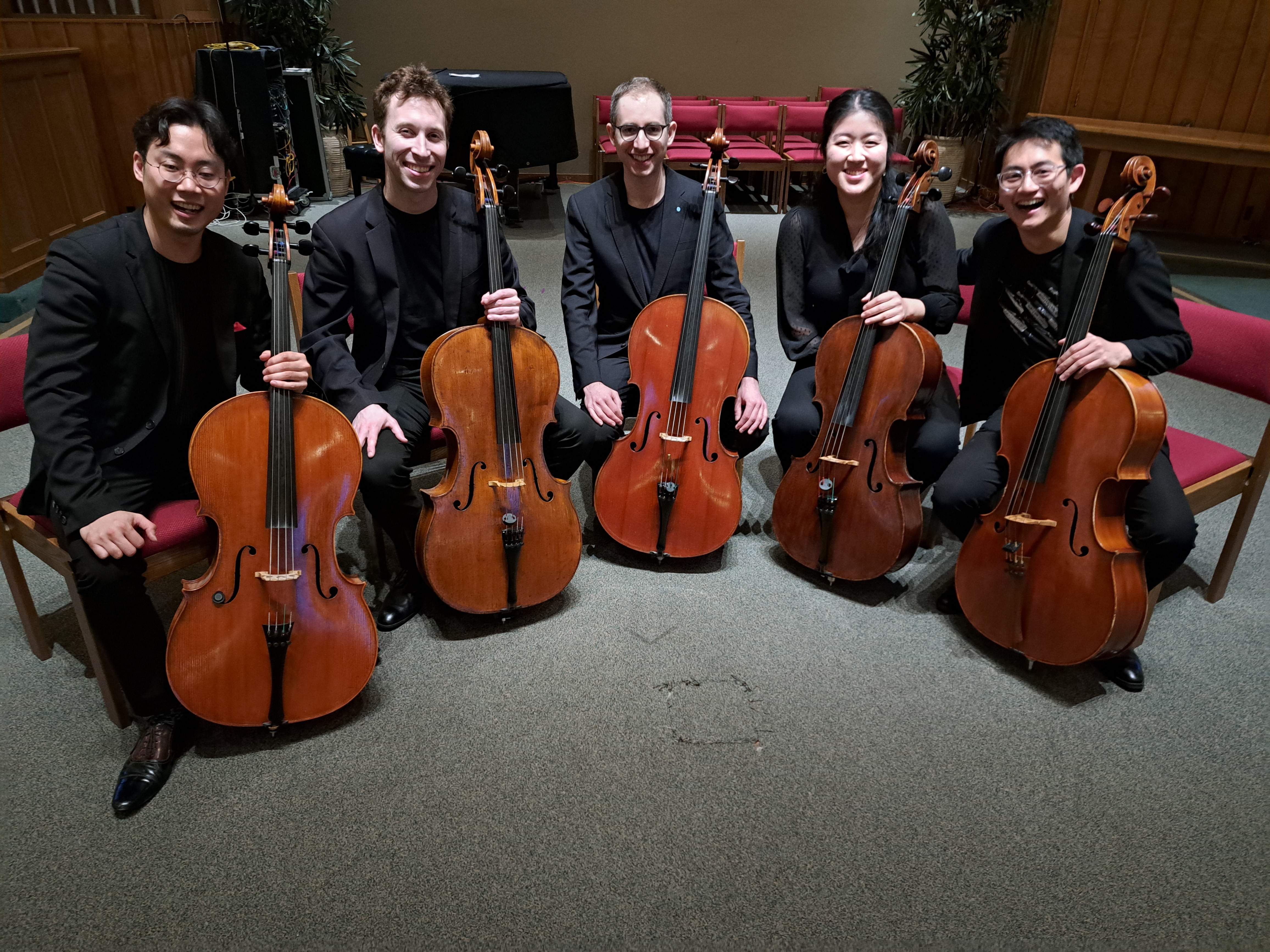SAKURA and the Art of Musical Arrangement
SAKURA Cello Quintet, from left: Yoshika Masuda, Michael Kaufman, Peter Myers, Stella Cho and Nathan Chan. Click for full photo.
by Abby Wasserman
In Japanese, sakura means the five-petaled cherry blossom, and members of SAKURA Cello Quintet treated their Chamber Music Marin audience March 12 to a rare musical flowering. All but one of the eleven selections in the program were arrangements, not surprising because until SAKURA formed, finding original scores for an ensemble of five cellos was difficult.
Cellists Stella Cho, Michael Kaufman, Yoshika Masuda, Peter Myers and guest artist Nathan Chan, seated in a half-circle, opened a generous program with Fauré’s dreamlike song cycle Cinq Melodies “de Venise,” Op. 58, composed in 1891, lushly arranged by Mr. Myers. The songs, based on poems by Paul Verlaine, are similar in mood and related in structure. Staccato bass notes in the original score became bass pizzicati, and arpeggios were passed from player to player like fine porcelain. The songs seemed an unfurling single composition rather than five separate songs.
The cello, which reached its present form in the early 1700s, is blessed with a voice like the human voice that ranges down from mezzo-soprano to resonant bass, with great sonic possibilities. It’s to the credit of the program’s arrangements (all but one by Peter Myers) that the sound of all five is so diverse.
Michael Kaufman arranged the second work, Dvořák’s Silent Woods, Op. 68. The Czech title is Klid, and it is a meditation on nature in three-quarter time. The cellos took turns spinning together and breaking apart in delicious harmonies—a lovely adaptation of the original, which was written for cello and piano.
Each of the group’s cellos had a slightly different tone so even when two played in unison, subtle differences emerged, and each instrument had as many moods as the virtuoso performers could muster: Ms. Cho’s light soprano can growl, Mr. Kaufman’s satiny tenor can warble. Because in this group there is no first chair, all the performers shift parts continually. The instruments may look the same, but as this concert proved, the cello is a quick-change artist.
The serene meditations of the first two selections turned fiery with De Falla’s Ritual Fire Dance, arranged from the ballet El Amor Brujo’s orchestral suite. The instruments created a loud humming sound like a hive of angry bees and dropped into a thrilling dance rife with buzzing, trilling, growling, drumming, stinging and sliding.
Sarabande, from Peter Myers’ original work for five cellos (“Stratigraphy”), was next. Speaking from the stage, the composer said the idea came from an opening chord sequence that was self-replicating. He described an image of an ancient shoreline on earth and of the procession of life coming to a climatic apocalypse. The Sarabande was fascinating in its very chromatics, its almost anti-harmonies over which melody arose and descended. It culminated with a fluttering trill of agitation and an unresolved question. It struck me that this is surely music for our time.
The exotic weave of Debussy’s The Girl with the Flaxen Hair was a faithful arrangement from the 1910 book Preludes. The five cellos braided the gorgeous strands of Debussy’s chord sequences, and Mr. Masuda’s cello line, playing the theme, floated on air. The last chords dipped deep and ascended to the final high note with lacelike delicacy.
The program’s first half culminated with Joe Hisaishi’s Merry-Go-Round of Life, from Studio Ghibli’s film Howl’s Moving Castle. The theme is sweet and soulful, a waltz that picks up pace until it spins like a carousel. The piece was originally scored for orchestra, and Mr. Myers was able to retain the orchestral richness in his arrangement.
After intermission, the cellists changed seats to perform Britten’s Dawn, a section of Sea Interludes from the masterful opera Peter Grimes. Shimmering and undulating, the arrangement evoked the rising sun and rippling waves. After its last hushed notes, without lowering their bows the quintet launched into Schubert’s anguished Erlkönig (The Elf King), played passionately and with great urgency, that again revealed the quintet’s ability to stand in for just about any combination of instruments.
The cellos’ tonal colors revealed themselves ever more richly in Rachmaninoff’s melancholy, wordless Vocalise lamentation. Mr. Masuda played the melody in a captivating string tenor voice with affecting rubato. The harmonic textures of the five cellos were glorious. The piece was written for high voice and piano but has been adapted for many different ensembles. This may have been the most beautiful arrangement I have heard.
Debussy’s Clair de Lune was next, with guest artist Nathan Chan initiating the melody. Mr. Chan (sitting in for absent SAKURA member Benjamin Lash) was a delight to watch. Like many cellists, he’s physically very expressive, and this arrangement by Mr. Myers retained the fragile delicacy of the original piano score.
Mr. Masuda introduced the last number, Chick Corea’s Spain. The piece begins (as does Miles Davis’s arrangement) with the haunting second movement of Rodrigo’s Concierto de Aranjuez. Then, as Mr. Corea takes off on his own compositional journey, SAKURA pulled out all the stops, showcasing even more of their instruments’ sonic possibilities.
It was an exhilarating finish to the concert, and a standing ovation confirmed the audience’s appreciation.
